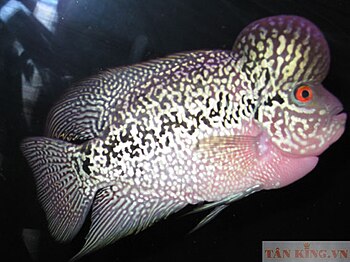Oscar Cichlid, also known for their scientific name Astronotus Ocellatus, is found in South America and native to Peru, Brazil, French Guiana and Columbia. Other common names include Velvet Cichlid, Marble Cichlid, and Tiger Oscar. These fish are rapid growers. Reaching an average of 12 inches in length, some have been known reach a total of 18 inches and weigh 3.5 lbs.
  |
Photo of a leucistic Long Finned Oscar (Astronotus ocellatus). Some have remarked that this strain is more difficult to care for than the strain found in the wild. However, this is not noticeable unless the specimen is under a lot of stress. The fish is a little bulkier due to carrying more fins.
(Photo credit: Wikipedia) |
Typically dark in colour, orange-ringed spots also known as ocelli are found around the gill area, dorsal fin, and on the sides towards the back end of the fish. Found in a variety of colours, Oscars can range from being mottled, all black or red, marbled, or albino. When becoming combative or territorial, they are known to change colour rapidly. Juvenile Oscars have spotted heads and are striped with wavy, orange and white bands.
Oscar Cichlids are known to be aggressive compared to other members in the cichlid family. Jack Dempsey's, Pacus, and Silver Dollars will work well as tank mates as well as other moderately aggressive cichlids.
Noted as being intelligent creatures from aquarists alike, they are able to distinguish their owners apart from strangers. Oscars are curious, playful, and popular among hobbyists.
Since Oscars are carnivores, their diet should consist of fish and insects. Feeder fish, brine shrimp, krill, and crickets are all acceptable food types. High quality prepared foods such as pellets and flakes can also be supplemented with the food types previously mentioned.
A 75 gallon tank per Oscar is the ideal size with a water temperature range of 70-80 degrees Fahrenheit. PH should be maintained between 6.5 and 7.0. Although Oscars are relatively hardy fish, water conditions must be kept clean and maintained. Improper water and tank maintenance can lead to certain diseases that Oscars are susceptible to, such as HITH, (hole in the head) a disease which affects the sensory organs in the lateral lines and face of the fish, thus causing pitting in both areas.
By Craig Wrightson
If you would like to learn more about Oscar Cichlids and their environment, visit my site African Cichlid Success
NEW eBook! Get Instant Access!
Learn everything you need to know about setting up and maintaining a perfect Cichlid Tank including the unbelievably simple secrets the professional breeders use on caring, feeding, breeding and diseases!
Article Source: EzineArticles
|









